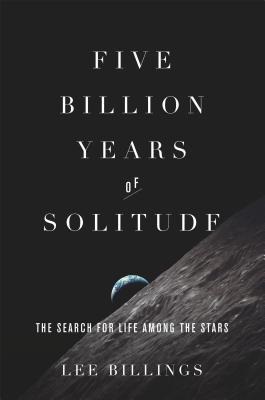Centauri Dreams
Imagining and Planning Interstellar Exploration
Arthur C. Clarke: A Life Remembered
Space writer Neil McAleer’s long association with Arthur C. Clarke culminated in Visionary: The Odyssey of Arthur C. Clarke (Clarke Project, 2012). A gifted journalist whose work has appeared in numerous magazines and newspapers, McAleer is also the author of The Omni Space Almanac, which won the 1988 Robert S. Ball Award from the Aviation and Space Writers Association. Neil recently reminded me that a new book on Clarke was about to appear, and in the post that follows, he gives us an overview of a title in which Fred Clarke, Arthur’s brother, makes an informative contribution, along with a host of writers and other Clarke associates. The photos in Arthur C. Clarke: A Life Remembered are worth the price of admission, and I’ve reproduced a few of them below with permission. Neil breaks the review down by contributing author and explains what you can expect from each. Ordering information is at the end.
by Neil McAleer
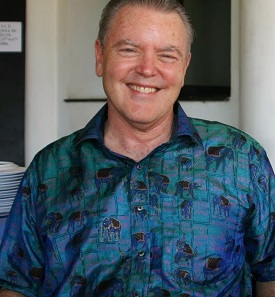
Arthur C. Clarke: A Life Remembered
$22.95 plus shipping. ISBN 978-1926837-26-0
Authors in order of first appearance: Fred Clarke, Robert Godwin, Mark Stewart, and Kelvin F. Long (multi-contributor chapters follow the chapters from the four authors in this review)
Fred Clarke
Chapter I – Childhood: Vignettes by Fred Clarke (25 pp.)
If the Guinness World Records had a category for “Devoted Brothers,” Frederick William Clarke (1921-2013), the second born son of Nora and Charles Clarke, would have held the world record since the first edition in 1955. Even so, Fred Clarke was his own man and shared with his brother Arthur a unique individuality and vitality in life. I think of the wonderful quote from Joseph Campbell: “The privilege of a lifetime is being who you are.”
Twenty-three (23) vignettes, all with titles, almost all humorous and positive anecdotes about growing up in Somerset England, introduce this accessible and many-peopled volume on the life and work of Arthur C. Clarke.
The lengths vary from 4 lines to 2 full pages—the longest including “Huish Grammar School” and “Star Gazing”; and the shortest, including “Cider Thieves!” and “Fred Enlists.”

Image: Arthur C. Clarke takes his first flight in an Avro 504. Nora Clarke is in the rear seat. Captain Percival Philips at the controls. Taunton circa 1927. Credit: BIS/Apogee Prime/Rocket Publishing. Published with permission.
Great, high-end quality black and white photographs, numbering 17, appear in this chapter, and their variety ranges from portraits of Arthur’s space cadet friends and colleagues to a special plaque, attached to the stone exterior of Arthur Clarke’s birthplace at 4 Blenheim Road in Minehead. (A total of 70 photographs in the book, with 2 tables on starships in fiction.)
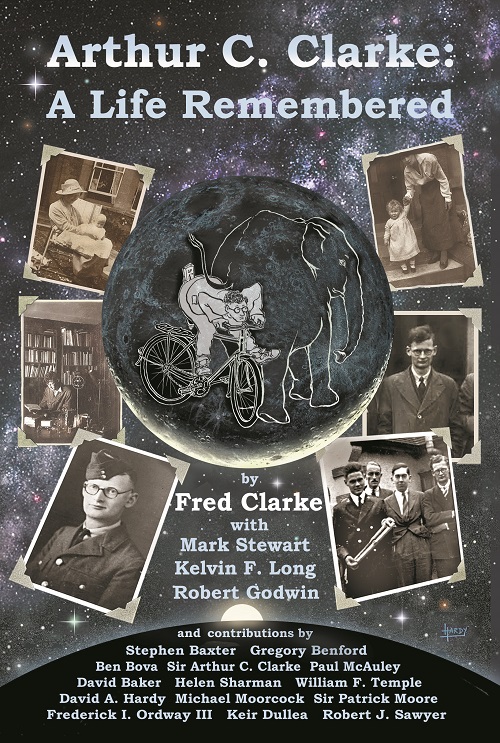
Robert Godwin
Chapter II – Early Days: From Ego to Fame (46 pp.)
Rob Godwin’s important Chapter II is a substantial contribution to Clarke’s early life, and its coverage of 20 years (1934-54) represents one-fifth of the book’s entire text. Indeed, this accessible, readable text tends to cloak its original and hard-won research from an expert and publisher in the space sciences–a devoted writer who knows the joy of discovering new treasures of a well-lived life. This labor of love also required the skills of a genealogical sleuth—tracking down, contacting, and interviewing many descendants of key contemporary influences in Arthur Clarke’s life.
After Godwin’s fine history, gold nugget pieces of reality from the early days come forth to complete the chapter via the still lasting magic of print—a time machine from Arthur’s pen and from the pen of his good friend and fellow space cadet, Bill Temple. These are three pieces from the classic fanzine, Novae Terrae, dated June 1937 (Clarke, 3 pp.), June 1938 (Temple, 5 pp.), and January 1939 (Clarke, 3pp.). Read them. They will transport you back to a time when Arthur was 20 years old.

Image: Arthur C. Clarke in his study at Ballifants. Credit: BIS/Apogee Prime/Rocket Publishing.
Chapter XII — Beyond 2001: The Gala (13pp.)
And later on in the book, third to last chapter, Godwin’s dramatic and colorful account of the Arthur C. Clarke Gala at the Playboy Mansion overflows with his genuine enthusiasm and gratitude for actually being there and playing a part of moving some of the events along smoothly. This reviewer, who was also present that November night just weeks after the September 11 attack, was reminded how much he had forgotten in 12 years! But to this day, seeing the living Arthur C. Clarke, from a half world away, projected as a 3D hologram standing at a podium opposite Star Trek Commander Patrick Stewart, will never be forgotten.
Mark Stewart*
Chapter IV – The Clarke Legacy: An Interview with Fred Clarke (6 pp.)
Mark Stewart, editor of the online monthly Odyssey, meets the other brother, Fred Clarke, for the first time, when Fred is closing in on his 90th birthday. With summary narration and quotes, Stewart writes up Fred’s delightful anecdotes as only Fred Clarke can tell them, with good humor and optimism. The short tales do not overlap with those of the Fred’s first chapter.
* Mark was accompanied by BIS members Kelvin F. Long and Colin Philp.
Chapter V – Tales from Taprobane*: An Interview with Nalaka Gunawardene (11 pp.) in December 2010.** Nalaka’s interview’s timeline stretched from the latter half of the 1980s to Clarke’s death in March 2008. Nalaka handled all public relations and media work upon his death. As Clarke’s assistant of many hats, the stories and insights into life with Clarke and his work are fresh and insightful.
*In three parts, with this Gunawardene interview as part one—and the longest. All three parts share the place: Sri Lanka, aka Ceylon and Taprobane. The other two parts are: “Rendezvous with Arthur,” Michael Lennick (6 pp.); and “The Brightest Star,” Helen Sharman (2 pp.)
** Colin Philp was present at the Gunawardene interview held at BIS Headquarters in London.

Image: Arthur in his beloved Sri Lanka. Credit: BIS/Apogee Prime/Rocket Publishing.
Michael Lennick, the producer of a Discovery television documentary on the film 2001: A Space Odyssey, writes the second part of Chapter V about his visit and interview with Arthur in 2000. He was astounded that his draft came out to exactly 2001 words! Serendipity! He left it that way—not wanting to press his luck. (5.3 pp)
And part three was written by astronaut Helen Sharman. Her narrative tells of her visit to Sri Lanka to meet Arthur and promote her book, which began with a foreword by Clarke. Sharman was the first British woman in space, who flew to the Mir Space station in 1991.( 92pp.)
Chapter X – Interplanetary Men: Arthur Clarke and Olaf Stapledon — Cosmic Visionaries (6 pp.)
Mark Stewart writes about one of Arthur Clarke’s most profound and consequential early influences in his work, Olaf Stapledon, whose books include the long-lasting, relevant, and classic novels, Last and First Men and StarMaker. Many other contemporaries of Clarke, including his lifelong friend, Patrick Moore, were equally influenced by Stapledon. And how did these “Deep Time and Space” enthusiasts get the famous writer to the youthful British Interplanetary Society to give a lecture in post-WWII 1948? Bob Parkinson, then President of the BIS, told Stewart before a lecture one night: “Clarke and a few others just went to where he was living at the time, and knocked on his front door; they just asked him to do it! …That’s how we got him to speak.”
Clarke had the honor of introducing Stapleton to the audience that evening, and Stewart gives several rare and great quotes from the lecture in this piece. A must read for the “Deep Time and Space” cadets.
Chapter XIV – Fred Clarke (2 pp.)
Mark Stewart writes this piece about the rare and wonderful lifetime relationship between the Clarke brothers who are now together forever in “Deep Time.” This heartfelt tribute of the first order has a lasting power to anyone who met and knew Fred Clarke.
Chapter XV – Fictional Last Word (2pp.)
Stewart extends the power of his tribute to Fred Clarke by flashing forward from the tribute’s last paragraph to this short, fictional image tale of the two brothers once again together.
Kelvin F. Long
Chapter VIII – Old Spaceship (3 pp.)
This chapter is divided into three sections: “The Spaceship” (Kelvin Long) – “Blueprint for a Starship” (Stephen Baxter) – “Creating a Self-Fulfilling Prophesy in Space” (Kelvin Long). Two tables appear in the chapter, one covering ACC’s spaceships in his fiction and nonfiction work; the second covering starships in the works of other science fiction writers.
“The Spaceship” is an overview introduction to the relationship between spaceships in fiction and spaceships in advanced engineering design.
Stephen Baxter’s section, “Blueprint for a Starship,” (9 pp.) is a look at the interstellar starships of the Icarus/Daedalus class, which respectively represent an ongoing and previous program of studies from the membership and associates of the British Interplanetary Society. All starship concepts in these two research programs travel at some fraction of the speed of light and none reach it. Three sample starship concepts from the final page table in Baxter’s essay give the cruise speed of the Daedalus Project as 0.12 c; Clarke’s Magellan in Songs from Distant Earth as 0.2c; and the Venture Star in James Cameron’s Atavar as 0.7c – all as speed-of-light percentages. The Table on the concluding page of Baxter’s “Blueprint” gives the neophyte starship student an excellent perspective—including the keyed references, one of which cites Paul Gilster’s Centauri Dreams (Springer 2004) as an excellent source for starships in science fiction.
Long’s “Creating a Self-Fulfilling Prophesy . . .” (6 pp.) concludes the chapter with an inspirational narrative about the many and varied ways Arthur left his mark on several generations of future space farers—what I call, “Arthur Clarke’s Deep Legacy,” in both time and space. This includes Long’s own renewed enthusiasm from Clarke’s lifetime work as well as a commitment to the interstellar vision that Long works toward, what Paul Gilster (whom I dub the “Master of the Deep”) named his book and website for — Centauri Dreams. But Long puts reality into his renewed vision by organizing the new interstellar research effort he names Project Icarus. “Where Project Daedalus showed that interstellar travel was possible in theory (proof of an existence theorem), Project Icarus aims to demonstrate it is theoretically possible in practice, not by building the vehicle but by demonstrating that the design is sufficiently credible and possible in the near-term.” And the Project Icarus mission also must fire up future generations of interstellar experts as they move into Deep Space and Time to reach new worlds.

Image: Clarke’s ‘The Sentinel’ as it appeared on the cover of New Worlds in 1954. Credit: Michael Moorcock.
Chapter XI – Before the Odyssey (6 pp.)
Kelvin Long compliments Mark Stewart’s chapter X, Interplanetary Men, by covering other early literary influences in Clarke’s youth. His primary focus is on David Lasser and his classic 1931 nonfiction book, The Conquest of Space, which describes the practical applications and future prospects for humankind of rockets and rocketry. He quotes Clarke on its importance to him at the age of 14.
——-
NOTE: Front and back matter, plus multi-contributor chapters now follow. All chapters by the four primary authors have been summarized, in order of appearance, prior to this note.
——-
Front Matter Overview – Acknowledgements by the four authors. Preface by Gregory Benford: “Remembering Arthur” (3 pp.). Benford’s upfront essay joins the large starship crew of admirers and personal friends who carry forth Clarke’s lifelong desire to reach other star’s and their worlds of sentient beings; Preface, by the four authors who man the bridge of the good starship, Arthur C. Clarke, which carries the legacy of his vision to future reality. Special Introduction by Angie Edwards, Fred Clarke’s daughter and Board Member of the Arthur C. Clarke Foundation. “This is the first truly personal memoir of my Uncle Arthur. . . .”
Back Matter Overview. Resources and Recommended Reading; Selected Papers by Arthur C. Clarke, covering 43 years,1938 to 1981. About the Authors, who take the helm of the Good starship Arthur C. Clarke.
Chapter III – Friends and Followers (10 pp.)
This chapter, short and sweet, has reminiscences of 5 friends who knew Clarke over long periods of time. They are, in order of appearance, Fred Ordway (met in 1950); Michael Moorcock (met in early 1960s); Ben Bova (met in 1956); Keir Dullea (met in late 1965), and writer Robert J. Sawyer (who met ACC only through his work–he read 2001: A Space Odyssey when he was 11, in 1971, but saw the movie when he was only 8, in 1968.
For the “general reader,” who might not be familiar with one or more of these five space cadets, there is a succinct mini-bio is at the end of each piece.
Chapter VI – Remembering Arthur: Members of the British Interplanetary Society Reminisce (12 pp.)
Seven members of the BIS tell their personal tales and connections to Arthur Clarke. In order of appearance they are:
- Martin Fry (Chair of the Space 82 BIS Conference in Brighton who interviewed Clarke via satellite link)
- David A. Hardy (Studied sciences at the College of Technology in Birmingham and met Arthur Clarke when he lectured there for the BIS in the early 50s)
- Mat Irving (The great model maker for BBC Television, Arthur’s friend, and BIS member, who last saw Clarke in 1999, at the British Film Institute showing of Kubrick’s remastered 2001 film print.)
- Bert Lewis (Met Clarke when he was a young student at Taunton Grammar School. Many years later in 1955 he stayed with Bert and his wife when on a lecture tour. The couple were challenged to get him to the dinner table because Arthur was completely engrossed in Bert’s great science fiction collection)
- Kelvin F. Long (Met Clarke at the London Science Museum in 1999. A fellow was pointing up to an exhibit, Arthur C. Clarke invented the communications satellite, and the man turned out to be Arthur. Kelvin and friends talked briefly with Clarke, and this changed Kelvin’s his life, which is now devoted to “rejuvenating the study on interstellar flight”)
- Sir Patrick Moore (Met Arthur at BIS when he was 12 and Arthur was 17—in 1934. They were fellow enthusiasts and both became great men in the space and astronomy fields. They were friends for 74 years!)
- Ray Ward (One of the great fans of Arthur C. Clarke, who met Arthur for the first time in 1971, when Clarke was in London and delivered a lecture at the BIS headquarters.)
- David Baker (Fellow of the British Interplanetary Society and currently the editor of its magazine, Spaceflight. He recalls the fascinating details of Kubrick’s advance men mining NASA’s concept and project art to supply realism to the film. Dr. Baker worked in the US space program for more than 25 years, and spanned the early days of the Gemini program, through the years of Apollo mission planning and with the Space Shuttle program during the 1970s and 80s. He’s been a genuine space cadet throughout his full career.

Image: Brighton 1987. David Brin, Fred Clarke, Charles Sheffield and Robert Forward. Credit: BIS/Apogee Prime/Rocket Publishing.
Chapter VII – Treading the Sands of Mars: Arthur’s work in Retrospect (20 pp)
Eight book reviews, one review of current state of space exploration, written by 7 reviewers, with Adam Crowl and Mark Stewart writing two each. One novel, The Sands of Mars, is reviewed twice, and the review is of a limited edition which presents his teenage writings. The reviewers are, in order of appearance:
Kelvin F. Long – The City and the Stars
John Silvester – The Sands of Mars
Adam Crowl – The Sands of Mars
Gregory L. Matloff – Childhood’s End
Paul McAuley – Rendezvous with Rama
Adam Crowl – Earthlight
Mark Stewart – 2001: A Space Odyssey
Andy Sawyer – Childhood Ends (Not the famous 1953 novel, but ACC’s teenage writings)
Mark Stewart – “Arthur’s Guide to the Universe” (A review of the current state of the planet’s space-faring, as seen through the works of Clarke)
Chapter IX – Father to the Man – Stephen Baxter (8 pp.)
“We seem to be young, in a very old Galaxy. We’re like kids tiptoeing through a ruined mansion.” — Stephen Baxter, Ark
And Arthur Clarke was the first kid in line to open up the doors that still were on their hinges. This piece by well-known novelist Stephen Baxter is a wonderful tribute from a successful and grateful author who was brought up on Clarke’s novels, stories, and nonfiction science writings.
There are many insightful personal and professional expressions of his late-in life friendship with Arthur Clarke, and the concluding paragraph of his essay is one of the best.
“A writer’s early works, before experience and craft take over, can be a richer expression of his/her deepest influences and subconscious yearnings than later material. By returning in his and later life to visions from his boyhood, Clarke was revisiting the wellspring of his own creativity.”
Chapter XII -Later Days: 90th Birthday Reflections* (3pp.)
This three-page transcript is Arthur C. Clarke’s last media appearance that was uploaded to YouTube one week before his 90th birthday — on December 9, 2007. His assistant, Nalaka Gunawardene, made this significant event happen — once he approached Arthur and got a high-sign go ahead. Its first appearance, recalls Nalaka, “made some international news and soon became a hit on You Tube.” My bet is that all Clarke fans alive today have seen this broadcast at least once, and millions of other viewers around planet Earth also saw Arthur Clarke and heard his final goodbye to the world.
*Readers who wish to know more about the “back story” of this final media appearance should refer to Neil McAleer’s definitive biography, Visionary: The Odyssey of Sir Arthur C. Clarke, chapter 44, “Two Media One Last Time.” (The eBook edition of this biography, published by RosettaBooks, is retitled as Sir Arthur C. Clarke: Odyssey of a Visionary, which has a new preface.
The Reviewer now humbly titles the review, The Good Starship Arthur C. Clarke, with the four authors on its bridge, taking the helm in turn. And there are 30 other crew members, all important to the mission of the good starship Arthur C. Clarke.
Beautiful night last night. Southern Cross
(a very feeble constellation) just above the
front gate, with Alpha Centauri beside it.
It always gives me an odd feeling to look
at Alpha and to realize that’s the next stop.
–Letter to Val Cleaver, 1955
——-
Arthur C. Clarke: A Life Remembered
$22.95 plus shipping. ISBN 978-1926837-26-0
Available from Apogee Prime Books through the links below.
http://www.apogeeprime.com/prime/bookpages/9781926837260.html
http://www.bis-space.com/2013/06/25/11092/out-now-arthur-c-clarke-a-life-remembered
This last link is the original announcement from Apogee Books
http://www.cgpublishing.com/9781926837260.html

Black Sky Thinking: The Technology of Nature
A graduate of Cambridge University, Rachel Armstrong completed her clinical training at the John Radcliffe Medical School at the University of Oxford in 1991 and in 2009 embarked on a PhD in chemistry and architecture at University College London. She now serves as co-director of AVATAR (Advanced Virtual and Technological Architectural Research) at the University of Greenwich, London, and as Visiting Research Assistant at the Center for Fundamental Living Technology, Department of Physics and Chemistry, University of Southern Denmark. In this essay, based on a late September presentation at FutureFest in London, Dr. Armstrong recalls the English soothsayer known as ‘Mother Shipton’ and the petrifying well in Yorkshire that has long been associated with her name. The ensuing thoughts on black sky thinking take us into the realm of ‘living architecture’ and her engagement with the worldship ambitions of Icarus Interstellar.
by Rachel Armstrong
“To exist is to change, to change is to mature, to mature is to go on creating oneself endlessly.” Henri Bergson
They said she was a born a crone. An abomination, forged from leftovers that Nature would not claim – spat out as a bastard child in a damp cave by the River Nidd, as the very moon shunned her.
They said her stench was so rotten that she walked on a cloud of flies.
They said she turned water into stone.
They said these things and much more. And yet they went in droves, down to the Petrifying Well to see ugly Old Mother Shipton.

They all came, hoping to influence their fates, since the woman who defied the very laws of Nature could also see what the future had to hold – and so, enable them to take corrective, or aversive measures. Yet the powers of this sorceress were incompletely revealed for she was also the guardian to a technology that could match the potency of Nature.
Yet, not all the things they said about Mother Shipton were untrue. Today her miraculous technology lies unclaimed, lurking in full view, as a tourist attraction.

While the Enlightenment gave us a new set of tools that replaced our oracles and used the powers of science to enable different kinds of predictions, even these approaches had their limits, being less reliable as time passed, or as events became increasingly complex. Indeed, even in our highly technologized era our ancient anxieties are stirred when our current toolsets cannot clearly see the future.

We have recently come to regard these limits as singularities, which are technologically mediated events that introduce time and complexity into our reality so rapidly that they render our predictive methods ineffective. Indeed, it is said they threaten to “rupture the fabric of human history”. They include a range of anticipated incidents such as, the AI singularity (where machine intelligence exceeds that of humans), the Transhuman singularity (where our bodies are no longer naturally made), the Virtual singularity (where we upload our identities) and even the Escape Velocity singularity (where human lifespans increase so dramatically they disrupt our current notions of humanity).

But although these singularities may seem diverse, they stem from a particular kind of thinking, which originates from an Enlightenment worldview. This is set to ‘hard’ control the future that involves accurately forecasting events, so that we can better deal with, design, or prevent them from happening.

Yet, the inability to know exactly what happens next, does not imply Faustian bargains to evade grey goo scenarios as Bill Joy may claim, but anticipates disruption in our experience of reality. Through GPS, scientific instruments and the data processing powers of modern computing, a model of the world has emerged that has increased our awareness of new existential risks to our human culture. They indicate we face an era of great changes that are posed by Nature herself. Over the course of this century we are likely to witness flooding, dramatic weather patterns and resource shortages, which will reach tipping points where systems behave unpredictably and which we are currently powerless to predict or prevent.

Nature does not obey the linear laws of machines but operates in complex, contextualised and irreversible ways, which exist beyond the singularity in places that we cannot see clearly. We may think of these conceptual opacities as the Black Sky, for which, we need a different toolset – this is Black Sky Thinking.
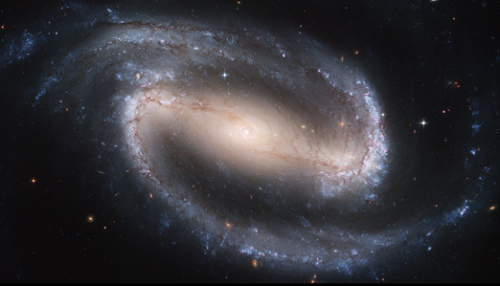
Black Sky Thinking is tactical, propositional and iterative. It draws existing threads of experience together and weaves a loose reality fabric from them. It then repeats the process until we can start to see the world around us again clearly and bump confidently up against its warp and weft, under new blue skies.

I’d like to talk about a particular singularity to offer an example of Black Sky Thinking – the Interstellar singularity, which occurs when humans leave the solar system. Our journey to the stars may be happening sooner than you think! Right now, Icarus Interstellar are catalysing the construction of a worldship in earth’s orbit within a hundred years.
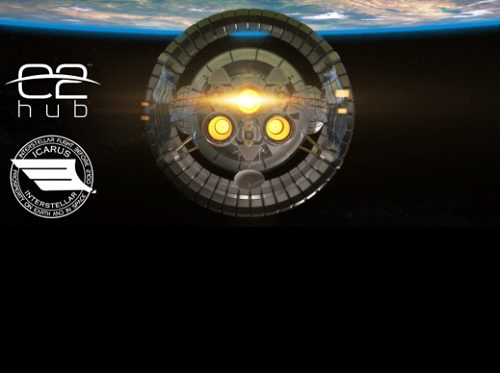
I am project leader for Persephone, which is one of the projects of Icarus Interstellar, and responsible for the living interior to this worldship. This may be thought of a unique kind of Nature that supports its space faring inhabitants. But since this project will be realised in more than one lifetime, and also exists within an age of exponential technological change, it is difficult – if not impossible – to see how can we even begin to imagine how we might deploy the necessary technologies to construct the living fabric for a worldship that does not already exist.
Persephone indeed inhabits Black Sky territory.
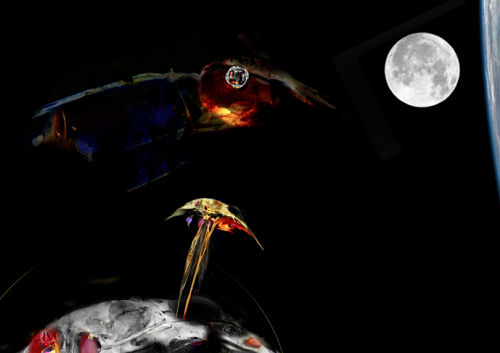
My work addresses the unknown challenges of building a living environment for the worldship by harnessing the computational properties of matter that is powered by sub atomic networks, chemical relationships and flows of energy. These take place in parallel and operate in real time, so we can think of the natural world as a kind of technology and harness its potential using the techniques of Natural Computing. This term was inspired by Alan Turing’s interest in the computational powers of nature and provides us with an alternative technological platform to machines, which helps us map and shape continually unfolding solution spaces.

The outputs of this approach propose a new kind of Nature with its own unique laws based in the physics and chemistry of the systems that underpin the worldship. So rather than extrapolating the consequences of conceptual models – Black Sky Thinking literally feels its way around the possibilities, by mapping and working with the nature of reality, without having to know the future. Persephone will shape her world from the bottom up through her soils, which may be considered as being a highly complex, self-producing Natural Computer.
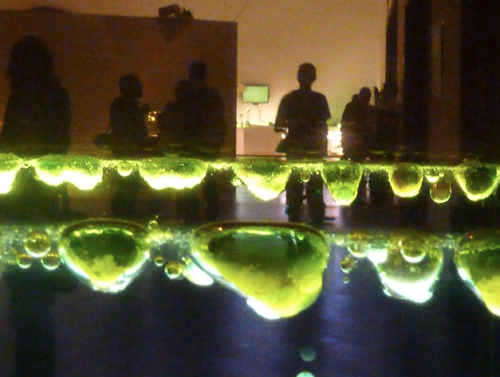
I have already conducted Natural Computing experiments using chemistries that are lively, and resist the decay towards equilibrium to grow structures like chemical worms and banded soil-like substrates.

Indeed, nature’s technologies are unlike those of machines. They are not made from a world of geometrically bound objects but are born from a dynamic field of possibility that is based on networks, relationships and flows. Such technologies are already so familiar to us that we take them for granted, as they exist beneath our feet. Indeed, our soils are the foundation of all civilizations. They occur spontaneously, acting as chemical transformers and give rise to fields of material probability, whose effects can be expressed in terms of land fertility. Soil technology may help us feel our way around a new kind of reality – not by consuming resources – but by endlessly transforming matter in complex entanglements of flow and metabolism that result in fundamentally life promoting events – ones that we can shape.

The story of Mother Shipton directly speaks to my work, but not because of her conceptually forged, bold prophesies that spoke of times when ‘men would walk and communicate underwater’ or women would wear ‘trousers’ to straddle transport as if astride a broomstick.

Nor am I drawn to the legend of a woman who embodies a complete deconstruction of our aestheticized views of Nature, which Timothy and Morton and Slavoj Žižek declare get in the way of dealing with the materiality of the actual world through our preconceptions.

I am drawn to Mother Shipton’s legend because of the very place she lived – as it harboured a natural computer. In Mother Shipton’s petrifying well, soft objects are turned to stone.
This has nothing to do with the anti-natural tendencies of a profane woman but may be attributed to the synthetic properties of elemental infrastructures. Nor are the features of the well simply a ‘natural’ phenomenon untouched by humans. They are carefully orchestrated by the drivers of our material reality, based in physics and chemistry, operating in conjunction with people who come to ritualistically place soft objects in the mineral-rich waters. Here the transformation begins. The soft object becomes saturated with water, which flows through the porous matrixes by capillary action and as the water evaporates from these permeable bodies, it leaves limestone-like deposits behind, like kettle scale.
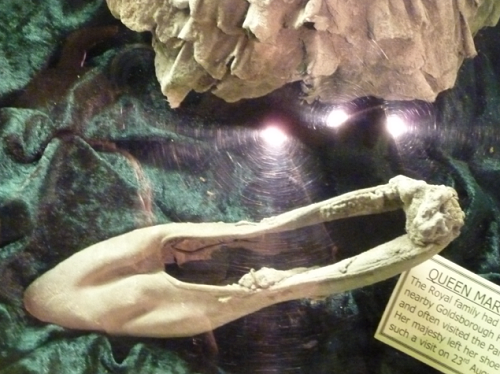
The mouth of the well drips stone objects from its damp matrix, which are hung by threads that suspend the soft bodies between the ground and the air, where they await to be transformed into something more lasting -that enfolds sacrificial objects such as, teddy bears, lobsters, brushes and even John Wayne’s hat – into the fabric of the rocks.

These processes, as magical and unconventional as they may seem, exist today and embody a rudimentary framework for a natural computer. In its current form, the stone spinning web can be considered as a primordial prototype to harness, what David Glissen calls, ‘pre-natural’ forces and offers a glimpse of what this emerging technological field may hold. Such technologies may not only be developed through our increasing knowledge of chemistry, physics and biology and but may also be evolved into more sophisticated, computational matrices that function as artificial soils and may eventually bring worldships to life – or help us invent new forms of construction, repair and recycling for our increasingly resource constrained cities.

So, these unnatural life forms – hag and worldship – share something in common with all living things in that they defy the very odds of their existence. Yet they do not survive by submitting to the random lottery of evolution but are post natural hybrids that manipulate the fabric of reality by drawing its material threads together and shaping it through their own force and will as incessant acts of survival and growth. Using the technology of natural computing these post natural bodies spin firm fabrics out of elemental cycles and grow new worlds from the very guts of Nature and make claim to an existence that they do not assume as a given.

In full view, the drip, drip, dripping of the Mother Shipton stone web permeates and transforms the soft bodies carefully placed in its immortal well. Sometimes it spins this way – and at other times it twists that way. From time to time, strange and unexpected nodules bulge expectantly and in those prodigious moments that precede a decision, it seems that life itself may split the sac, and all is possible.

“The idea of the future, pregnant with an infinity of possibilities, is thus more fruitful than the future itself, and this is why we find more charm in hope than in possession, in dreams than in reality.” Henri Bergson, Time And Free Will

Interstellar Wanderers
Because of my fascination with exotic venues for astrobiology, I’ve always enjoyed Karl Schroeder’s novels. The Canadian writer explored brown dwarf planets as future venues for human settlement in Permanence (2002), and in his new book Lockstep (soon to be published by Tor, currently being serialized in Analog), Schroeder looks at ‘rogue’ planets, worlds that move through the galaxy without a central star. Imagine crimson worlds baked by cosmic radiation, their surfaces building up, over the aeons, the rust red complex organic molecules called tholins. Or consider gas giants long ago ejected from the system that gave them birth by close encounters with other worlds.
Objects like these and more are surely out there given what we know about gravitational interactions within planetary systems, and they’re probably out there in huge numbers. I’m not going to review how Lockstep uses them just yet — in any case, I haven’t finished the book — but we’ll return to its ingenious solution to time and distance problems in a future post. Right now I just want to mention that one of Schroeder’s characters muses upon ‘a hundred thousand nomad planets for every star in the galaxy.’ Now that’s some serious real estate.
If the number sounds like a novelistic exaggeration, it’s nonetheless drawn from recent work. Schroeder is invoking the work of Louis Strigari (Stanford University), who has studied the possibilities not only of planets ejected from their own systems but those that may form directly from a molecular cloud. The figure of 105 free-floating planetary objects for every main sequence star is from a 2012 paper in Monthly Notices of the Royal Astronomical Society (you can read more about Strigari’s ideas in ‘Island-Hopping’ to the Stars).
Rogue planets would be tricky to find but gravitational microlensing should help us set constraints on their actual numbers, and as we’ll see below, direct imaging has its uses. If rogue worlds are available in such quantities, we can imagine a starfaring culture capable of exploiting their resources. We can even speculate that a thick atmosphere that can trap infrared heat coupled with tectonic or radioactive heat sources from within could sustain elemental forms of life even in the absence of a star. Tens of thousands of objects in nearby interstellar space would obviously be a spur for exploration.
A Newly Found Orphan World
Eighty light years from Earth floats a solitary planet that has been discovered through its heat signature in data collected by the Pan-STARRS 1 wide-field survey telescope on Maui. In mass, color, and energy output, the world is similar to directly imaged planets. As you might expect, PSO J318.5-22, a gas giant about six times the mass of Jupiter, turned up during a search for brown dwarfs, delving into the datasets of a survey that has already produced about 4000 terabytes of information. The discovery was then followed up through multiple observations by equipment on nearby Mauna Kea, with spectra from the NASA Infrared Telescope Facility and the Gemini North Telescope indicating the young, low-mass object was not a brown dwarf.

Image: Multicolor image from the Pan-STARRS1 telescope of the free-floating planet PSO J318.5-22, in the constellation of Capricornus. The planet is extremely cold and faint, about 100 billion times fainter in optical light than the planet Venus. Most of its energy is emitted at infrared wavelengths. The image is 125 arcseconds on a side. Credit: N. Metcalfe & Pan-STARRS 1 Science Consortium.
“We have never before seen an object free-floating in space that that looks like this. It has all the characteristics of young planets found around other stars, but it is drifting out there all alone,” explained team leader Dr. Michael Liu of the Institute for Astronomy at the University of Hawaii at Manoa. “I had often wondered if such solitary objects exist, and now we know they do.”
The find is interesting on a number of levels, not least of which is that observations of gas giant planets around young stars have shown that their spectra differ from those of L- and T-class brown dwarfs. Young planets like these, according to the paper on this work, show redder colors in the near-infrared, fainter absolute magnitudes at the same wavelength and other spectral peculiarities that suggest the line of development between brown dwarfs and gas giant planets may not be as clear cut as once assumed. The paper makes clear how complex the issue is:
PSO J318.5?22 shares a strong physical similarity to the young dusty planets HR 8799bcd and 2MASS J1207?39b, as seen in its colors, absolute magnitudes, spectrum, luminosity, and mass. Most notably, it is the ?rst ?eld L dwarf with near-IR absolute magnitudes as faint as the HR 8799 and 2MASS J1207?39 planets, demonstrating that the very red, faint region of the near-IR color-magnitude diagram is not exclusive to young exoplanets. Its probable membership in the ? Pic moving group makes it a new substellar benchmark at young ages and planetary masses.
A landmark indeed, and here the Beta Pictoris moving group, a collection of young stars formed about twelve million years ago, is worth noting. Beta Pictoris itself is known to have a young gas giant planet in orbit around it. The newly detected PSO J318.5?22 is lower still in mass than the Beta Pictoris planet and it is thought to have formed in a different way. The paper goes on:
We ?nd very red, low-gravity L dwarfs have ?400 K cooler temperatures relative to ?eld objects of comparable spectral type, yet have similar luminosities. Comparing very red L dwarf spectra to each other and to directly imaged planets highlights the challenges of diagnosing physical properties from near-IR spectra.
The beauty of objects like these from an astronomical point of view is that we don’t have to worry about filtering out the overwhelming light of a parent star as we study them. Co-author Niall Deacon (Max Planck Institute for Astronomy) thinks PSO J318.5?22 will “provide a wonderful view into the inner workings of gas-giant planets like Jupiter shortly after their birth.” The discovery also gives us much to think about in terms of future explorations as we contemplate a cosmos in which perhaps vast numbers of planets move in solitary trajectories through the galaxy.
The paper is Liu et al., “The Extremely Red, Young L Dwarf PSO J318-22: A Free-Floating Planetary-Mass Analog to Directly Imaged Young Gas-Giant Planets,” in press at Astrophysical Journal Letters (preprint). Also intriguing is Abbot and Switzer, “The Steppenwolf: A proposal for a habitable planet in interstellar space” (preprint).

Five Billion Years of Solitude
About a third of the way into his new book Five Billion Years of Solitude: The Search for Life Among the Stars (Current, 2013), Lee Billings describes a time capsule that was sealed in July of 1963 near the Cabrillo Freeway in San Diego, though it has since been moved. Within it was a book that looked a century ahead, with contributions from politicians, astronauts, military figures and others about the world of the future. Copies of the book, titled 2063 A.D. are available, and within them one can find the musings of Nobel-laureate Harold Urey, who worried about our use of energy and noted that largely because of the need for electricity, US fossil fuel consumption had increased eightfold between 1900 and 1955.
Was the trend sustainable over the long haul? Urey doubted it, and he was hardly alone, for the need for energy seems to impose sharp limits on what a society can do. Billings notes the work of Tom Murphy (UC San Diego), who works with a long-term 2.3 percent increase in energy usage per year, yielding a factor-of-ten increase every century. Things happen quickly over time — by 2112 the world is consuming 120 terawatts, a number that rises to 1200 by 2212. Cover every bit of land with photovoltaic solar arrays and assume 20 percent efficiency and you can supply the world of 2287, which will need something on the order of 7,000 terawatts.
Building Toward Kardashev Type III
You can see where this is going, and Billings is expert at connecting the march of numbers with real events and the people who can explain them. First, here is what happens once we’ve got all that land covered with solar-power arrays:
From there, increasing the efficiency of the photovoltaics to a miraculous 100 percent and covering the oceans as well as the continents would allow the 2.3 percent annual growth in energy use to persist for another 125 years, taking our steadily growing civilization into A.D. 2412 before it outpaced the total amount of sunlight falling upon the Earth. Another energy source, nuclear fusion, could potentially sustain an annual 2.3 percent growth rate for some centuries beyond this, at least until the waste heat from the vast amount of power being produced evaporated the oceans and turned Earth’s crust to glowing slag. For a planet-bound civilization, the boiling point of water and the melting points of rock and metal place insurmountable limits upon the expansion of energy use.
A grim prospect, but perhaps an informative one. Talking to planet hunter Gregory Laughlin (UC-Santa Cruz), Billings brings up the search for extraterrestrial intelligence, a bit out of Laughlin’s wheelhouse considering that he spends most of his days teasing out the faint signatures of distant exoplanets, leaving SETI to those who specialize in it. Intriguingly, though, Laughlin tells him that if a SETI detection ever does come, it will likely be extragalactic.That, of course, is a mind-boggling thought, but it follows directly out of the energy constraints above.
After all, Freeman Dyson came up with ‘Dyson spheres’ in their various configurations as a way of solving the energy problem, at least for a time. A Dyson sphere or ‘shell’ operates through a cloud of energy collectors completely surrounding the parent star, perhaps constructed by dismantling entire planets. A galaxy in which Dyson sphere building on a massive scale was occurring would be an interesting one indeed, gradually dimming in the optical while infrared from the enclosing shells became more and more apparent. There have been, in fact, searches made to look for signatures like these, though so far to little effect. James Annis (FermiLab) has studied 137 galaxies looking for candidates for this kind of engineering, and we are on the cusp of further studies looking for what Andrei Kardashev once described as Type III civilizations.
A Dyson sphere, according to Billings, would capture about 400 billion petawatts of power, equalling the Sun’s output, but even here that 2.3 percent growth in energy use catches up with us. A single Dyson sphere can no longer meet its builders’ energy needs after a millennium at this rate, while within about 2500 years, we would be using the energy of an entire galaxy. Billings asks whether the fact that we don’t see stars or galaxies dimming into the infrared may not be telling us something profound about our own expectations of exponential growth. That ever increasing upturn in our charts of the future may, over time, be the result of a temporary historical anomaly.
Science and Character
Although I’ve focused on a specific question out of Five Billion Years of Solitude, it’s a deliberate attempt to get at the jewel-like complexity of the larger work. Open to a page at random and you will find the kind of issues we kick around here on Centauri Dreams under discussion by some of the top minds in the field. Moreover, Billings has a twin purpose. He’s out to illustrate the vistas being opened to us by our exoplanet explorations (and by astrophysics at large) while putting us in touch with many of the remarkable individuals who ply this trade, some of whom may be the first to identify a planet like our own around another star, and perhaps the first to find unmistakable signs of life in its atmosphere.
Thus we meet Frank Drake, whose Project Ozma launched the SETI effort and whose Drake Equation has helped us understand the factors involved in searching for life. Billings’ account of the small SETI conference convened at the Green Bank observatory in West Virginia in 1961 gives us the origins of the equation and its reception among an audience that included such stellar figures as Philip Morrison, Bernard Oliver, John Lilly, a young Carl Sagan and Harold Urey himself, whose Nobel had come from his discovery of deuterium. The Green Bank conference was all about whether SETI made sense, whether there was a serious possibility of detecting signals from an extraterrestrial civilization, and we’ve been parsing the problem ever since.
Billings is expert at finding the telling detail, which in Drake’s case may be his love of orchids (he maintains over 200 hanging in pots and strewn over tables in the greenhouses outside his Santa Cruz home). Even more striking, though, is the stump of a giant redwood that he used to explain growth over time to his children, counting tree rings that extended back 2000 years. What I love about Five Billion Years of Solitude is the way Billings can work with an object like this and its multi-millennial reach while then extracting the larger cosmological message. In the passage that follows, he moves with panache from Earth years to galactic time-frames:
Over the course of the tree’s 2,000-year existence, the Milky Way had fallen nearly five trillion miles closer to its nearest neighboring spiral galaxy, Andromeda, yet the distance between the two galaxies remained so great that a collision would not occur until perhaps 3 billion years in the future. In 2,000 years, the Sun had scarcely budged in its 250-million-year orbit about the galactic center, and, considering its life span of billions of years, hadn’t aged a day. Since their formation 4.6 billion years ago, our Sun and its planets have made perhaps eighteen galactic orbits— our solar system is eighteen “galactic years” old. When it was seventeen, redwood trees did not yet exist on Earth. When it was sixteen, simple organisms were taking their first tentative excursions from the sea to colonize the land. In fact, fossil evidence testified that for about fifteen of its eighteen galactic years, our planet had played host to little more than unicellular microbes and multicellular bacterial colonies, and was utterly devoid of anything so complicated as grass, trees, or animals, let alone beings capable of solving differential equations, building rockets, painting landscapes, writing symphonies, or feeling love.
This is fine stuff, and you will find passages to equal it throughout the book. Along the way, Billings speaks not only to Drake and Gregory Laughlin, but to Geoff Marcy, to Jim Kasting. He talks paleoclimatology with sedimentary geologist Mike Arthur (Pennsylvania State) and ponders space telescope breakthroughs with Matt Mountain, who directs the Space Telescope Science Institute. With Terrestrial Planet Finder in its confusing multiplicity of forms still on ice and starshade proposals for JWST still in the realm of theory rather than practice, Wesley Traub (JPL) explains the maddening frustrations of trying to design cutting-edge equipment. We may not see a true Terrestrial Planet Finder until the 2030s, but that doesn’t mean the effort stops. We still have missions like TESS (Transiting Exoplanet Survey Satellite) in the works.
Working with the Possible
Billings’ conversations with Sara Seager (MIT) offer a wonderful segue from crisis into opportunity. Seager began as a cosmologist but swiftly switched to working on exoplanets with Dimitar Sasselov at Harvard. Moving increasingly toward questions of astrobiology and how to characterize habitable planets, she has been a tireless conference organizer and advocate for exoplanetary studies at a time of budgetary crisis. Her “The Next 40 Years of Exoplanets” conference at MIT’s Media Lab in May of 2011 was in several respects a call to arms, and Billings was there to hear her exhortation: “So I convened all of you here, and that’s why we’re recording this, because we want to make an impact and we want to make that happen. We are on the verge of being those people, not individually but collectively, who will be remembered for starting the entire future of other Earth-like worlds. That’s why we’re here.”
I wasn’t at the MIT conference but did follow most of it via online streaming, and I still recall Geoff Marcy’s anger at the lack of progress that had been exemplified by the failure to follow through with Terrestrial Planet Finder, the interferometric version in particular. It was at this conference that Marcy called for an Alpha Centauri probe “even if it takes a few hundred years or a thousand years to get there.” Such a mission would, he believed, energize and engage young people and jolt a moribund NASA into new life, and it would draw amply on international resources.
But Seager’s announcement that she was going to be devoting a substantial part of her time to the commercial spaceflight industry surprised many in the audience. Seager has a get-the-job-done approach that focuses on solutions no matter how far afield they may take her. As depicted in Billings’ shrewd and graceful prose, she is a complex, driven scholar with a taste for outdoor adventure and a habit of endless invention. If NASA won’t build a TPF, why not build Seager’s ExoplanetSat, on the model of one tiny satellite with telescope and solar panels focusing in on a single star at a time. Fly them in their hundreds on the cheap. Get things done.
You get to know these people through Billings’ words, and he’s adept at capturing their voice for extended quotations, letting them have the lead in describing their own work. In addition to the character portraits that inevitably emerge, the book is studded with the tools and concepts of exoplanetology. It is a poignant and inspiring look at an emerging discipline that mixes the human triumphs and foibles of key scientists (watch them fight over who discovered what) with a scholarly rigor — someone just coming upon the exoplanet field will find everything from planet detection to spectroscopy, habitability, geology and climate laid out with precision. I am hard pressed to think of any book I have read so voraciously, and with such continuing admiration.

Mars: The Interstellar Connection
Aerospace engineer Gerald W. Driggers embraced the dreams of Dr. Werner von Braun and his team at an early age and was privileged to meet and work with many of them. He was a prominent figure in studies of space colonization and industrialization with Dr. Gerard K. O’Neill in the 1970’s and also served as an officer in the US Air Force working on satellite launch vehicles. He has published over 35 technical papers and general interest articles and contributed to three books on technical subjects, but is now turning his attention to science fiction, authoring a series of books called The Earth-Mars Chronicles. Gerald and his wife became the first U.S. sponsors of the Mars One Project, whose objective is to place a team on Mars in 2023. A portion of the proceeds from sales of “The Earth-Mars Chronicles” goes to the Mars One Project. For 17 years, Gerald has lived on a series of boats because, in his words, “It was the closest thing I could get to a space ship.” He currently resides in Florida with his wife and Wilson the cat.
by Gerald W. Driggers
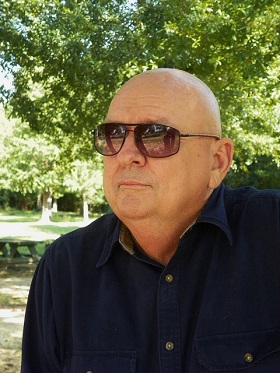
I was in the middle of working on The Earth-Mars Chronicles Vol. 2 Home for Humanity when the opportunity arose to submit an abstract for the second Tennessee Valley Interstellar Workshop. The review committee selected one of the two abstracts I submitted with the title “Martians Will Make the Best Interstellar Voyagers.” My research into human factors related to extended isolation away from Earth (i.e. settling Mars) led me to an appreciation of how many issues were time and distance independent. Following that chain of logic provided me with the title of my presentation. However, the concept of a connection between going interstellar and settling Mars grew as I delved further into the subject matter.
Although I applaud heartily the current enthusiasm exhibited at starship and interstellar conferences and symposia, I am convinced that the roadmap to the stars must include suitable infrastructure and capability within our own solar system. This sentiment was expressed by Paul Gilster in Centauri Dreams with this statement commenting on the Deep Space Industries announcement on 22 Jan 2013 of a new asteroid mining initiative. “Could it be the beginning of the system-wide infrastructure we’ll have to build before we think of going interstellar?” Equally as insightful was the comment “I think before we ever really undertake sending something to another star, we will probably have to be masters of our own solar system,” made by Les Johnson in an interview with Space.com. The infrastructure mentioned by Paul and the mastery referenced by Les both have many dimensions including the human as well as the technical.

A question I posed to myself was: What are the elements of the human dimension? There has been considerable research in this area over the past fifty years and luckily much of it was summed up in 2012 by Dr. Nicholas Kanas and Dr. Rhawn Joseph in a table of long duration space mission stressors (in Colonizing Mars: The Human Mission to the Red Planet, edited by Levine and Schild, Cosmology Science Publishers, 2012). In the following list items one through nine were summarized by Dr. Kanas and number ten is from the work of Dr. Joseph.
- 1. Extended separation from family and friends (Potentially forever – added by me)
- 2. Unknown psychological effects of long-term low gravity and high radiation
- 3. Extreme feelings of isolation and loneliness
- 4. Lack of support from Earth due to distance and communications delays
- 5. Increased autonomy and dependence on on-board resources
- 6. Limited social contact and interpersonal novelty
- 7. Filling leisure time with meaningful activities
- 8. Increased risk for medical and psychiatric illness due to time away from home
- 9. Earth-out-of-view phenomenon
- 10. Concerns over sexual tension, pregnancy and normal childbirth
My objective was to evaluate how the human population of Mars would compare to other pockets of humanity in a possible era of starship development so I picked 100 years as a target for extrapolation. Making an accurate specific prediction of where we will be in the Solar System 100 years from now is totally impossible so I examined a number of scenarios stretching from interplanetary stagnation (no fun and of no use to us) to highly optimistic where humans are operating throughout the inner Solar System. I subsequently picked the optimistic scenario with Mars settlements, exploitation of NEO and main belt asteroids, and lunar mining and settlement being mature and growing in 2113. This scenario was used to define where there would be permanent concentrations of people suitable to provide crew for an interstellar voyage.
The evaluation and comparison criteria are too detailed to present here but consisted of considerations of levels of automation and remote control for mining operations, maintenance and repair; likelihood of families as part of a large staffing; and likelihood of permanent long-term (lifetime) residency. My conclusion was that the three most viable sources for interstellar voyagers would be the Earth (by definition), the Moon and Mars. The next step was a subjective assigning of a measure of confidence related to an individual’s coping with the stressors based on their background and experience.

As I stated this is highly subjective, but I believe an examination of the environment and attributes one would expect from a citizen of Mars may assist in understanding my red, orange and green assignments. The very existence of expanding multi-generational Mars settlements implies that the individuals and culture will have the following characteristics although the number of generations required to achieve steady state in all areas is unknown.
- a. A stable social structure in an isolated, self-reliant environment.
- b. Have learned how to handle diversity in a society of limited size.
- c. Physically and mentally stable population in a less than 1g environment.
- d. Totally self reliant and capable of making anything they need.
- e. Minimal ties to Earth.
- f. Physically adapted to a lower atmospheric pressure.
- g. Physically and mentally adapted to living in an artificial environment.
- h. Mentally and physically adapted to the foods available.
- i. Accepts living in a machine generated environment with no reservations, but understands the responsibilities.
- j. No Earth (or Moon) out-of-view mentality.
- k. Comfortable with limited infrastructures such as pharma and health care.
- l. No uncertainty & anxiety over whether subsequent generations will be healthy.
Mars residents will by definition score well in all 12 of these categories. Lunar residents are less likely to score as well in categories d, e, j, and k. It is not possible to score the last factor (l) because it is currently unknown whether normal pregnancy, childbirth, and development are possible in the Lunar 1/6 Earth gravity environment. The population on the Moon could conceivably be composed of adults and children above a certain age who were born on Earth, whereas a growing population on Mars will not happen unless normal pregnancy, childbirth and development are possible. Human beings simply do not flock to a place where they cannot have children and raise families. Subsequently, I ranked Mars higher than the Moon in this category.
This then makes my case that a significant multi-generational population on Mars will provide a hearty pool for selection of low-risk interstellar voyager candidates. Unfortunately, my assessment of milestones on the way to having that population did not fit the 2113 target date I was initially using as a goal. There are far too many details to go into here, but the evolution time for in-space infrastructure and transportation does not appear to support a flourishing population on Mars before about 2140. There are, however, a number of wildcards in the space deck that could change this. Mars One, Inspiration Mars, Space X, Planetary Resources, Deep Space Industries and a host of other private and commercial entities are striving to significantly accelerate my timeline. I do wish them all well.
Here are my parting thoughts from my presentation. Although not absolutely essential technically, it seems intuitively obvious that humanity will expand beyond Cis-Lunar space before embarking on an interstellar voyage. But do we have to expand well beyond the asteroid belt before entertaining serious interstellar ambitions? I conclude that the answer is no, even if Jupiter has to be exploited to obtain the necessary ³He. Also, advocating for the right near-term infrastructure is the equivalent of advocating for interstellar flight, so the sooner we settle Mars, the sooner we will have our “…system-wide infrastructure…” and be “…masters of our own solar system.”
If we get it right on Mars we are much more likely to get it right in interstellar space.

Deep Time, Big History, and Existential Risk
Nick Nielsen thinks big, as his previous work in these pages and elsewhere has shown. His presentation on “The Large Scale Structure of Spacefaring Civilization” at the 2012 100YSS conference examined humanity’s growth as defined and enabled by the structure of spacetime itself. His continuing work with Heath Rezabek weighs the factors that threaten a technological civilization, while considering what we can do in response. An author and contributing analyst with strategic consulting firm Wikistrat, Nielsen here looks at our concepts of time and the emergence of ‘Big History,’ which might be called ‘history in a cosmic context.’ We are now developing the tools that, used properly, can address and resolve issues of existential risk.
by J. N. Nielsen

James Hutton is often credited with the origins of the modern conception of geological time, which is sometimes called “deep time.” Looking upon the Bass Rock in the outer part of the Firth of Forth James Hutton is said to have remarked, “…the mind seemed to grow giddy by looking so far into the abyss of time.” (The Bass Rock: Its Civil and Ecclesiastic History, “Geology of the Bass,” p. 82) Hutton also became famous for saying of the deep time of geology, “we find no vestige of a beginning, no prospect of an end.”
Deep time is also called geological time, because the order of change in geology, essentially invisible in terms of human time, is revealed in deep time. The deep time of the geological record is time enough for continents to move and reshape themselves, for mountain ranges to rise and fall, and for the planet entire to pass through a range of climates from a glaciated snowball earth to a steaming global swamp.

Image: Geologist, physician and naturalist James Hutton (1726-1797). This is Hutton’s portrait as painted by Sir Henry Raeburn in 1776.
For all this diversity, science has given the peculiar name of uniformitarianism, since although conditions and structures of the Earth change continually, the forces acting on the Earth are uniform over time. Charles Lyell especially developed geology along the lines of uniformitarianism, and this had a great influence on Darwin, who carried Lyell’s Principles of Geology along with him during his journey on the Beagle.
By the late twentieth century, however, Stephen J. Gould was able to argue in his paper “Is Uniformitarianism Necessary?” that to say that geology embodies uniformitarianism is nothing more than to say that geology is a science, and this is not controversial, so that it becomes unnecessary to explicitly formulate uniformitarianism as a scientific hypothesis, which freed up Gould and others studying deep time to consider other models of the past that are slightly less uniform but no less “deep” in the temporal sense (e.g., punctuated equilibrium).
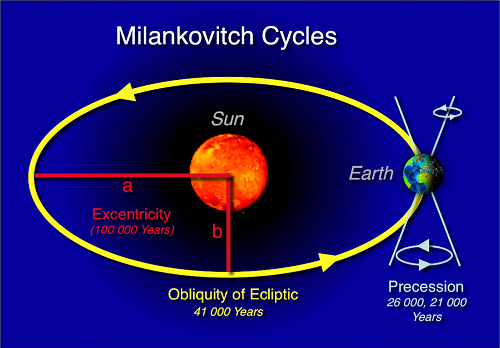
Deep Time in Biology: Astrobiology
It took biologists time to come to a full realization of the antiquity of life on Earth, just as it took geologists time to formulate a time scale adequate to describe the processes of geology. The geologists got there first, but they got there with the help of paleontologists. William Smith, who drew the first modern geological map of England, dated rock strata by the fossils they contained and so established a correlation between geological time and biological time. (This is a story told in the excellent book by Simon Winchester, The Map that Changed the World.)
It is only in our time that we are coming to realize that the geology of the Earth and the life of our planet must be understood in a cosmological context. The formation of the Earth itself was a process that could be characterized as astrophysical before it was geological, and the astrophysics of our solar system continues to this day to shape the surface of our planet.
Life on Earth has shared the fate of the planet that hosts it, and this life has been shaped by cosmological events also. The earth, for example, wobbles in its orbit, and in fact the sun bobs up and down in the plane of the Milky Way as the galaxy spins. The wobbling of the Earth consists of eccentricity, axial tilt, and precession, which together are referred to as Milankovitch cycles, and which significantly affect the insolation of the Earth, i.e., the amount of sunlight reaching the Earth’s surface. This wobbling and bobbing has consequences for life on earth because it changes the climate – sometimes predictably and sometimes unpredictably. But regularity (or, if you prefer, uniformity) is at least partly a function of the length of time we consider.
Astrobiology has come about from the need to see life in its cosmological context, which is as much as to say that astrobiology is the biology of deep time. And we may need time even deeper than that provided by the geology of Earth to explain life. A recent well-publicized study, “Life Before Earth” (see preprint here) by Alexei A. Sharov and Richard Gordon, argued that projecting the complexity of life backward through time implies that life originated approximately 9.7 billion years ago, which is almost twice as old as the earth, which implies in turn that earth was “seeded” with life as soon as it was cool enough to support life (or sufficiently stable to sustain life), rather than independently arising on Earth.
Deep Time for Humanity: Big History
A scientific conception of deep time in geology and biology was the necessary prerequisite to the introduction of deep time into history, which latter was, from its ancient Greek inception up through the twentieth century, a humanistic rather than a scientific discipline. “History” was synonymous with written language, and the “historical period” was the period of human existence coincident with the use of written language.
The relatively recent emergence of what is now often called “Big History” is a result of many factors, not the least of which were the technologically facilitated dating methods that began to emerge in the middle of the twentieth century – most famously, carbon-14 dating. With the ability to date artifacts scientifically, a new and precise chronology emerged in parallel with written chronology, but this new chronology could be pushed far deeper in the past, and thus provide human beings with our own “deep time.”
The best known names in the field of Big History today – David Christian, Cynthia Stokes-Brown, and Fred Spier – have drawn heavily on the many special sciences to assemble an overall “big picture” view that places human history in the context of scientific historiography, wrapping up the whole in a chronology that extends from the Big Bang to the present day.
This Big History picture of human beings and the world in which they live has made us aware of the fact that our planet, our bodies, and our lives have been shaped by forces much larger than our planet, and even larger than our solar system. Ancient gamma ray bursts coming from deep within the galaxy may have affected the path of evolution of life on earth; closer to home, the Earth’s insolation has driven climate, and climate is a primary driver of evolution. So it seems that we are not only “star stuff” as Carl Sagan said, but our star stuff continues its relation to the stars even after it has become Earth-bound.
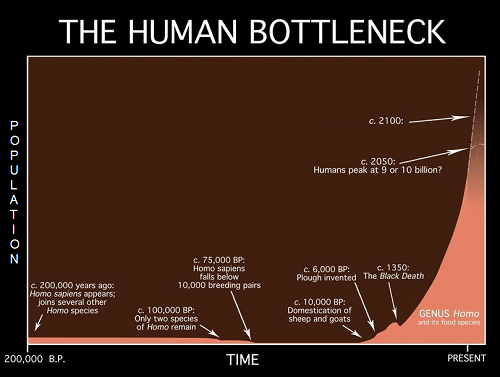
Ignorance is Bliss
In the early history of our species, ignorance of existential risk was bliss. Human beings, their hominid predecessors, and the species that preceded them in turn, were fortunate merely to survive, i.e., to overcome the immediate existential risks posed by the local climate and conditions and to go on living from day to day. And when the small initial population of homo sapiens was geographically restricted to a small area of Africa, these local risks were profound and potentially existential.
It is widely postulated that human beings passed through an existential bottleneck about 70 thousand years ago (cf. population bottleneck), when there may have been only a few thousand representative individuals of our species alive. This existential bottleneck in human history was once theorized to be the result of the Mount Toba explosion, though recent research has suggested that this is not the case. There is an ongoing debate as to whether this existential bottleneck was a short, sharp event brought about through sudden climatic change (of the sort that might be triggered by a geophysical event) or a “long bottleneck” lasting up to 100,000 years. Whatever the cause, we got through by the skin of our teeth – though we did not know at the time how lucky we were.
Human beings were once an endangered species on the Earth. No longer. No we have made our way into every habitat on the planet (with the exception of Antarctica, unless one counts the scientific bases there) and have ambitions of controlling the climate of the entire planet. The trouble we have gotten ourselves into by the unrestricted burning of fossil fuels could yet be mitigated by geoengineering through the relatively simple and straight-forward means of placing a slight shade between ourselves and the sun (a “Dyson dot” in the terminology of Robert G. Kennedy, cf. Dyson Dots), but this is only one of many dangers that face us that must be understood on cosmological scales of time and space.

Why Existential Risk Now?
Why should existential risk be a concern for us now, when we have gotten along just fine for several hundred thousand years (and Earth before us for billions of years) without any awareness of existential risk? Are we not sounding a bit like Chicken Little proclaiming that the sky is falling? Do we not risk becoming just another doomsday prophet holding up a sign that says that the end of the world is coming?
Existential risk is a concern for us now because we are capable of understanding existential risk in a way that we would not have been able to understand existential risk in the past. The slow and incremental accumulation of scientific knowledge has made it possible for human beings to formulate the idea of deep time and to apply it in turn to geology, biology, cosmology, and even to human history. Just as a conception of deep time was a requisite for the modern scientific study of geology and biology, scientific historiography and big history was a requisite for the formulation of the idea of existential risk.
We have, essentially by dumb luck, made it thus far. This “dumb luck” may be the Great Filter of SETI and Fermi paradox debates, i.e., whatever it was the prevented a slew of other technological civilizations from emerging and crowding our little corner of the Milky Way, which now seems to us (now, that is to say, that we know how to listen) eerily silent. Some may credit it to divine providence rather than dumb luck.
However it happened that we survived, we have survived so far, but we have no guarantee of continued survival. We do, however, have knowledge on our side. Our scientific progress steadily adds to our knowledge of the world, and that makes us ever more clearly aware of our relationship to the wider world, which in this context means cosmology.
How consciousness of existential risk differs from Chicken Little and doomsday prophets is not only in its rational and scientific character, but, just as importantly, in the rational and scientific character of the response to existential risk. Scientific study of the universe can reveal to us the dangers that we face in great detail, and even the likelihood of our having to face them (a sterilizing gamma ray burst is not very likely, but a massive solar flare could very well burn out electrical power grids around the world). Moreover, the same science implies rational, scientific means of existential risk mitigation.
We are not limited to waving our arms and shouting that the sky is falling, or calling for our fellow man to repent because the end is nigh; we can formulate and execute specific existential risk mitigation strategies and measure their efficacy with the same sober scientific precision. And this is exactly what we need, because we can no longer count on being lucky. If the Great Filter still lies in the future, it will not be luck that gets us beyond it, but our own grit and determination.

